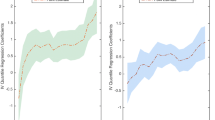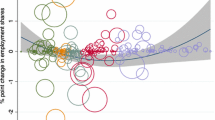Abstract
This paper analyzes the employment and wage trends for Indian workers for the period 2005–2012 by computing the task-content of occupations (Autor et al. in Q J Econ 118(4):1279–1333, 2003a; Autor et al. in Rising Wage Inequality: The Role of Composition and Prices, National Bureau of Economic Research, Cambridge, MA, 2003b; Acemoglu and Autor in Skills, Tasks and Technologies: Implications for Employment and Earnings, 2011; Autor and Dorn 2013). Three main occupation categories are obtained- routine manual, routine cognitive and non-routine cognitive. The analyses reveal evidence of job polarization for India - middle skilled jobs that are most likely to be routine cognitive, have the lowest share in employment, whereas routine manual jobs have much higher shares in employment. Further, the share of non-routine cognitive jobs has been increasing over the period under consideration at the expense of routine manual jobs. While the share of routine cognitive jobs is low, it does not reflect a substantial decline over the period. Finally, while analyzing wage trends the author finds that the average wages of workers engaged in non-routine cognitive tasks is rising the fastest, followed by those engaged in routine cognitive tasks, while average wages of workers in routine-manual tasks have witnessed the lowest rate of growth.

Source: National Sample Survey Employment-Unemployment rounds of 61, 62, 64, 66, and 68. Author’s own calculations

Source: National Sample Survey Employment-Unemployment rounds of 61, 62, 64, 66, and 68. Author’s own calculations

Source: National Sample Survey Employment-Unemployment rounds of 61, 62, 64, 66, and 68. Author’s own calculations

Source: National Sample Survey Employment-Unemployment rounds of 61, 62, 64, 66, and 68. Author’s own calculations

Source: National Sample Survey Employment-Unemployment rounds of 61, 62, 64, 66, and 68. Author’s own calculations

Source: National Sample Survey Employment-Unemployment rounds of 61, 62, 64, 66, and 68. Author’s own calculations

Source: National Sample Survey Employment-Unemployment rounds of 61, 62, 64, 66, and 68. Author’s own calculations
Similar content being viewed by others
References
Acemoglu, D., and D. Autor (2011), “Skills, Tasks and Technologies: Implications for Employment and Earnings”, Vol. 4 of Handbook of Labor Economics, chap. 12, pp. 1043–1171. Elsevier.
Asplund, R. and E. Barth (2011), “Polarization of the Nordic Labour Markets”, Finnish Economic Papers, Vol. 24, No. 2, pp. 87–110.
Autor, D.H. and D. Dorn. 2013. "The Growth of Low-Skill Service Jobs and the Polarization of the US Labor Market”, American Economic Review, Vol. 103, No. 5, pp. 1553–1597.
Autor, D.H., F. Levy and R.J. Murnane (2003a), “The Skill Content of Recent Technological Change: An Empirical Exploration”, Quarterly Journal of Economics, Vol. 118, No. 4, pp. 1279–1333.
Autor, D.H., L.F. Katz and M.S. Kearney (2003b), “Rising Wage Inequality: The Role of Composition and Prices”, Working Paper No. 11628, National Bureau of Economic Research, Cambridge, Massachusetts.
Autor, D.H., A. Manning and C.L. Smith (2016), “The Contribution of the Minimum Wage to US Wage Inequality Over Three Decades: A Reassessment”, American Economic Journal: Applied Economics, Vol. 8, No. 1, pp. 58–99.
Dustmann, C., J. Ludsteck and U. Schönberg(2009),“Revisiting the German Wage Structure”, The Quarterly Journal of Economics, Vol. 124, No. 2, pp. 843–881.
Fonseca, T., F. Lima, S. Pereira, “Job Polarization, Technological Change and Routinization: Evidence from Portugal”, Working Paper. https://fenix.tecnico.ulisboa.pt/downloadFile/1689468335561623/paper_polarisation.pdf.
Goos, M. and A. Manning (2007), “Lousy and Lovely Jobs: The Rising Polarization of Work in Britain”, The Review of Economics and Statistics, Vol. 89, No. 1, pp. 118–133.
Michaels, G., A. Natraj and J. Van Reenen (2013),“Has ICT Polarized Skill Demand? Evidence from Eleven Countries over 25 Years”, Review of Economics and Statistics, Vol. 96, No. 1, pp. 60–77.
Acknowledgements
The author is extremely grateful for SuchitAgarwal’s excellent research assistance on the paper. All errors and omissions are the author’s.
Author information
Authors and Affiliations
Corresponding author
Rights and permissions
About this article
Cite this article
Sharma, S. Employment, Wages and Inequality in India: An Occupations and Tasks Based Approach. Ind. J. Labour Econ. 59, 471–487 (2016). https://doi.org/10.1007/s41027-017-0078-z
Published:
Issue Date:
DOI: https://doi.org/10.1007/s41027-017-0078-z




